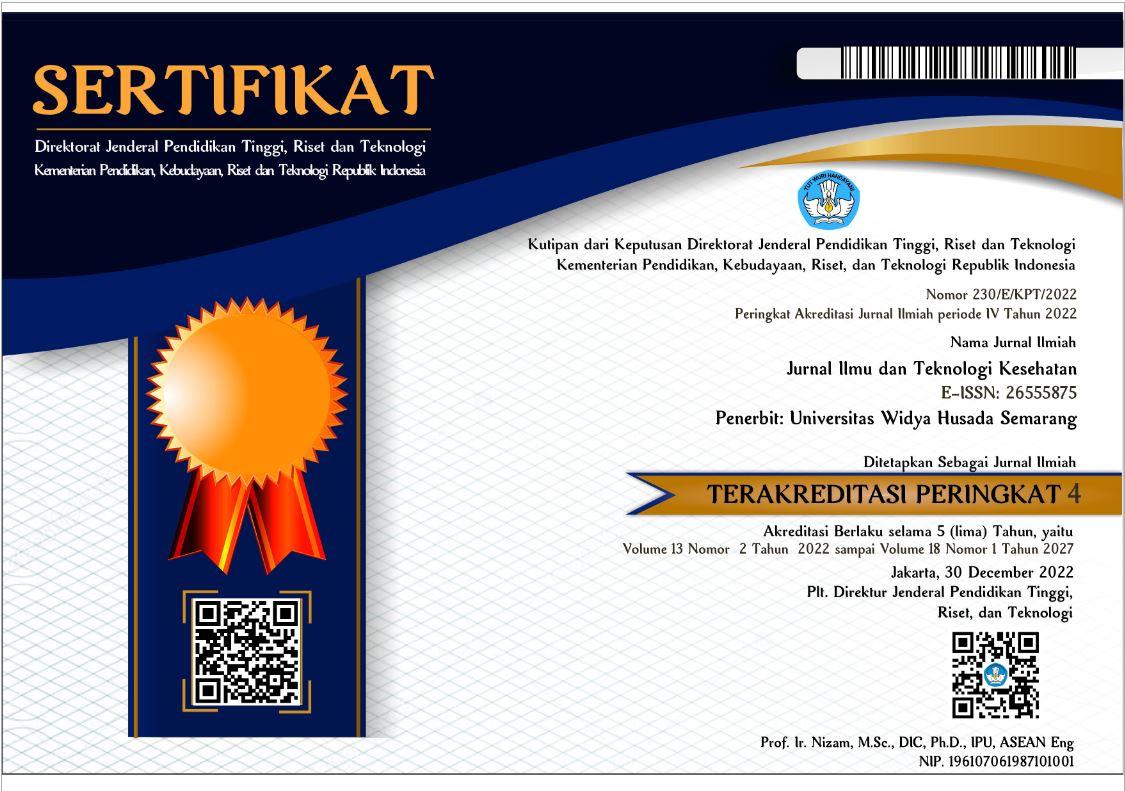STUNTING BONE AGE EXAMINATION IN STUNTING CHILDREN IN THE RADIOLOGY INSTALLATION OF SIJUNJUNG HOSPITAL, WEST SUMATRA
Abstract
Keywords
Full Text:
PDFReferences
Alhazmi A, Aldossary M, Palomo JM, Hans M, Latimer B, Simpson S. Correlation of Spheno-occipital Synchondrosis Fusion Stages With a Hand-Wrist Skeletal Maturity Index: A cone beam computed tomography study. Angle Orthodontist.2021;91(4):539.
Aguayo, V. M. and Menon, P. (2016) ‘Stop stunting: Improving child feeding, women’s nutrition and household sanitation in South Asia’, Maternal and Child Nutrition, 12, pp. 3–11. doi: 10.1111/mcn.12283
Ariani, A P. (2017). Ilmu Gizi. Yogyakarta : Nuha Medika
Badan Pengawas Tenaga Nuklir (BAPETEN). 2011. Peraturan Kepala Badan Pengawas Tenaga Nuklir No. 8 Tahun 2011, tentang Keselamatan Radiasi Dalam Penggunaan Sinar-X Radiologi Diagnostik Dan Intervensional https://jdih.bapeten.go.id/files/_000197_1.pdf diakses pada tanggal 17 November 2018.
Branca F, Ferrari M, 2002. Impact of Micronutrient Deficiencies on Growth: The Stunting Syndrome. Ann Nutr Metab 2002,46(suppl 1):8-17
Caulfield LE, et al. 2006. Stunting, Wasting, and Micronutrient Deficiency Disorders. In: Disease control priorities in developing countries, 2nd edition. World Bank Group, Washington (DC)
Clark. 2005. Clark’s Positioning in Radiography. 12th ed. London: Arnold Publishers.
Dekkar, L.H., Plazas, M.M., Bylin, C.M.A dan Villamor, E. 2010. Stunting assosiated with poor socioeconomic and maternal nutrition status and respiratory morbidity in Colombian schoolchildren. Food and Nutrition Bulletin. 31: 2
Diamanti-Kandarakis E, et al. 2009. Endocrinedisrupting Chemicals. An Endocrine Society Scientific Statement. Endocrine Reviews, 30(4): 293-342
Gibson RS, 2005. Principles of Nutritional Assessment, Second Edition. Oxford University Press, Inc., New York.
Marlinata, C. 2010. Hubungan Status Gizi dengan Jarak Intermolar pada Dewasa Usia 18-25 tahun. Skripsi. FKG Universitas Jember. 59-60
Martono, Nanang. (2012). Metodelogi Penelitian Kualitatif. Jakarta: Rajawali Pers
Mikhail WZA, et al. 2013. Effect of Nutritional Status on Growth Pattern of Stunted Preschool Children in Egypt. Academic Journal of Nutrition 2(1):01-09.
Nandy S, et al. 2005. Poverty, child Undernutrition and Morbidity: New Evidence from India. Bulletin of the World Health Organization; 83(3):210-216.
Nilsson O, et al. 2005. Endocrine Regulation of the Growth Plate. Hormone Research, 64:157– 165.
Paudel R, et al. 2012. Risk Factors for Stunting Among Children: a Community Based Case Control Study in Nepal. Kathmandu University Medical Journal, 10(3):18-24
Proffit, WR. 2007. Contemporary Orthodontics. St. Louis, Toronto, London: The CV Mosby Company. 244-246, 340-344
Rahardjo, P. 2009. Ortodonti Dasar. Surabaya: Airlangga University Press. 24-27
Sumarmi, M. S. (2016) ‘Maternal Short Stature and Neonatal Stunting : an Inter-Generational Cycle’, Interna, (April)
The Lancet’s series on Maternal and Child Undernutrition Executive Summary. 2008. (http://tc.iaea. org/tcweb/abouttc/tcseminar/ Sem6-ExeSum.pdf)
Verhoef H, et al. 2002. Stunting may Determine the Severity of Malaria Associated Anemia in African Children. Pediatrics;110:e48.
Victora, C. G. et al. (2008) Maternal and child undernutrition: consequences for adult health and human capital’, The Lancet, 371(9609), pp. 340–357. doi: 10.1016/S0140-6736(07)61692-4
Vitolo MR, et al. 2008. Some Risk Factors Associated With Overweight, Stunting and Wasting among Children Under 5 Years Old. Jornal de Pediatria, 84 (3):251-257.
WHO Multicentre Growth Reference Study Group, 2006. WHO Child Growth Standards: Length/ height-for-age, weight-for-age, weight-forlength,weight-for-height and body mass index-for-age: Methods and development. Geneva, World Health Organization. Available at: http://www.who.int/ childgrowth/standards/technical_report/en/ index.html
World Health Organization (WHO). Weise A. WHA Global Nutrition Targets 2025: Stunting Policy Brief. 2012; Available from:http://www.who.int/nutrition/topics/globaltargets_stunting_policybrief.pf
WHO. (2019). Maternal mortality key fact. https://www.who.int/news-room/factsheets/detail/maternal-mortality
.
DOI: https://doi.org/10.33666/jitk.v14i2.566
Refbacks
- There are currently no refbacks.

This work is licensed under a Creative Commons Attribution 4.0 International License.
| Published by : Widya Husada Semarang University | ISSN : 2086-8510 (Print) | ISSN : 2655-5875 (Online) | |
| INDEXED BY | |||
 |  |  |  |
| MAP LOCATION | |||






